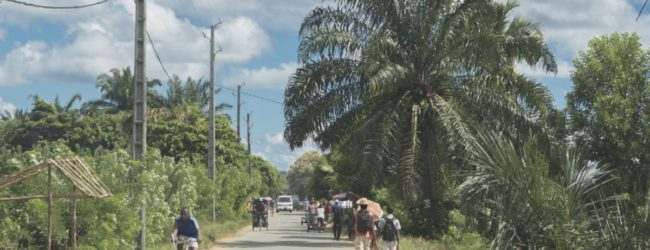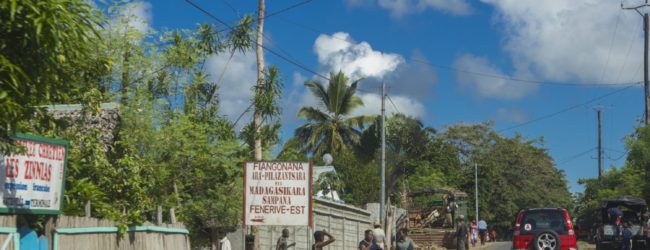Distribution of the local form Fenoarivo:
Fenoarivo (former French Fénérive) is a hut village in eastern Madagascar in Analanjirofo region. It is located along RN5, the road between Toamasina (Tamatave) leading to Nosy Boraha (St. Marie), approximately 130 km north of the first-mentioned. The village is surrounded by secondary vegetation, rice fields, coffee, cloves, and cocoa plantations and not really worth a visit. From the huts, it is only a few hundred meters to walk until the Indian Ocean.
Appearance of the local form:
Panther chameleons in and around Fenoarivo are relatively unknown but partially have a spectacular coloring. The males are blueish-dirty-white, and when stressed they become almost completely white with only a little red pattern (sometimes only some red dots, sometimes red stripes). Here and there, this unique coloration gave the name “snowball” to panther chameleons of this local form, although the local forms of Soanierana Ivongo, Mahavelona and Nosy Boraha (St. Marie) may also have some almost white specimen.
Weight table

Gewicht = weight in grams, Kopf-Rumpf-Länge = snout-vent-length in cm, Weibchen = females, Männchen = males
Since 2015, we have been measuring the weights of chameleons found by us in Madagascar, as far as the animals (and our scales) participate. In the long term, we aim to obtain an average weight in relation to snout-vent-length (measured from the tip of the nose to the cloaca) for each species from as many measurements as possible. It is important to know that all weights were measured towards the end of the rainy season (= best food supply), so these should be maximum weights on Madagascar. Triangular symbols in females mean not pregnant, round symbols mean pregnant. In Furcifer pardalis, contrary to our original assumption, it has so far turned out that there are no serious differences in the ratio of SVL to weight between the individual local forms.
| Jan | Feb | Mar | Apr | May | Jun | Jul | Aug | Sep | Oct | Nov | Dec | |
| Average temperature | 26 | 26 | 26 | 24 | 22 | 20 | 20 | 20 | 21 | 23 | 24 | 26 |
| Minimum temperature | 22 | 22 | 21 | 19 | 16 | 14 | 14 | 15 | 15 | 18 | 19 | 21 |
| Maximum temperature | 31 | 31 | 31 | 29 | 27 | 25 | 25 | 26 | 27 | 8 | 29 | 30 |
| Rain days | 14 | 13 | 9 | 7 | 6 | 5 | 6 | 5 | 4 | 5 | 9 | 13 |
We have collected the data given above over several years with thermometers and hygrometers at the finding places of the chameleons. "Average temperature" means that values of a whole month have been calculated to one average value per month. For example all measured minimum temperature values of February have been calculated to one average minimum temperature for February. In plain language, this means single peak values of a day may be a little higher or lower than the average minimum and maximum temperatures. It is possible that a location has an average maximum temperature of 29°C, but one day during that month it had 33°C or even 35°C there.
Climate in Fenoarivo and Soanierana Ivongo is warm all year long due to the coastal location. During rainy season from October to April, temperatures raise regularly above 30°C in sunny places, nights do not drop below 21°C. Humidity is high and it rains every other day.
Dry season has little lower temperatures with night drops to 15°C at lowest. It rains much less, you have to expect rain showers only every couple of days.Habitat:
Panther chameleons here inhabit open landscapes with trees, palms and lots of bushes. They usually avoid the savanna-like areas directly at the sea.


















